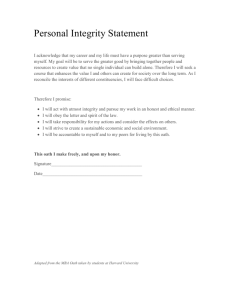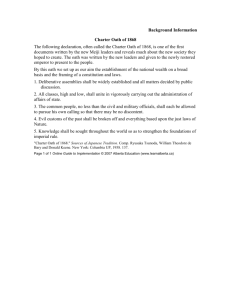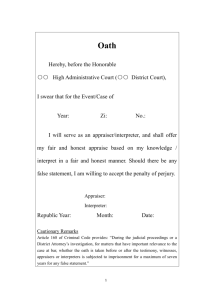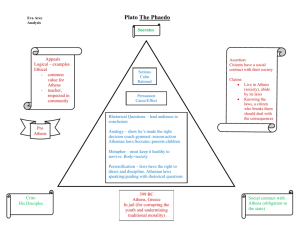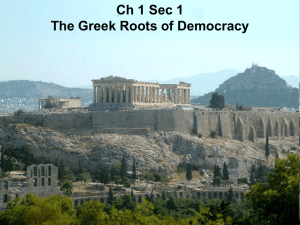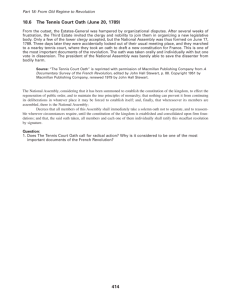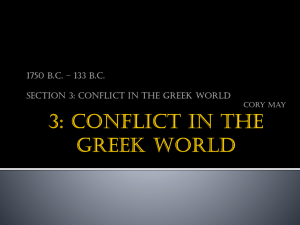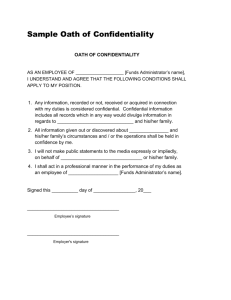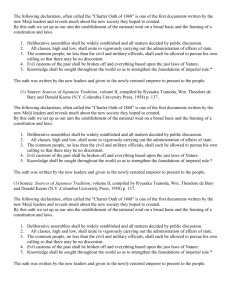Dike. Rivista di storia del diritto greco ed ellenistico
advertisement
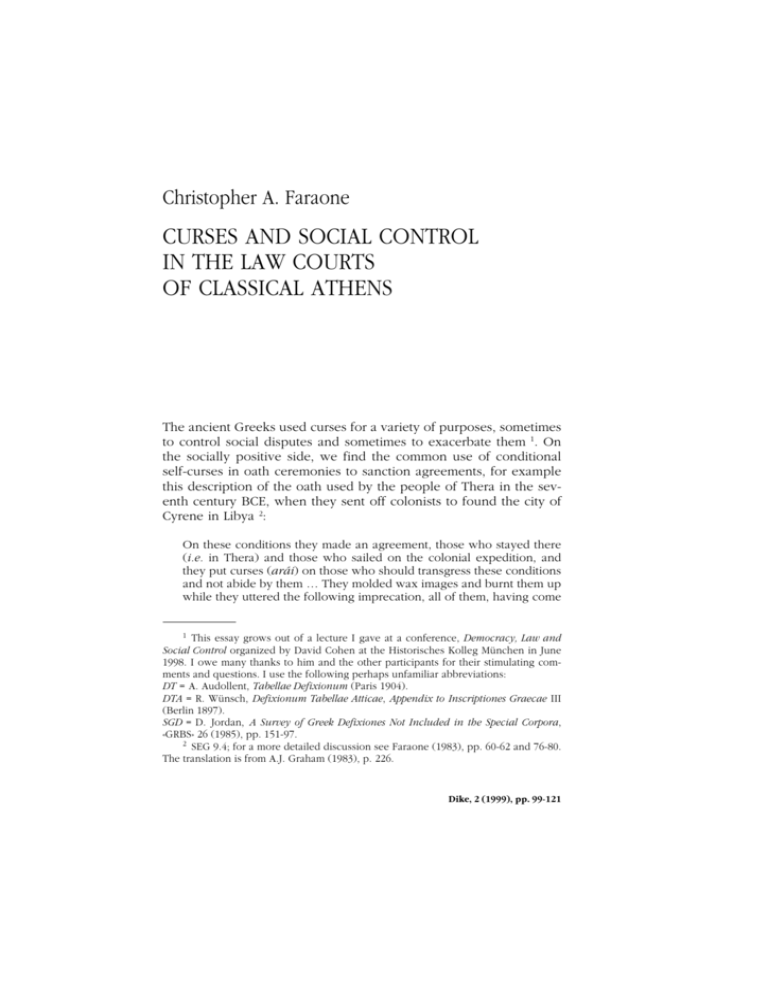
Curses and Social Control in the Law Courts of Classical Athens Christopher A. Faraone 99 CURSES AND SOCIAL CONTROL IN THE LAW COURTS OF CLASSICAL ATHENS The ancient Greeks used curses for a variety of purposes, sometimes to control social disputes and sometimes to exacerbate them 1. On the socially positive side, we find the common use of conditional self-curses in oath ceremonies to sanction agreements, for example this description of the oath used by the people of Thera in the seventh century BCE, when they sent off colonists to found the city of Cyrene in Libya 2: On these conditions they made an agreement, those who stayed there (i.e. in Thera) and those who sailed on the colonial expedition, and they put curses (arái) on those who should transgress these conditions and not abide by them … They molded wax images and burnt them up while they uttered the following imprecation, all of them, having come 1 This essay grows out of a lecture I gave at a conference, Democracy, Law and Social Control organized by David Cohen at the Historisches Kolleg München in June 1998. I owe many thanks to him and the other participants for their stimulating comments and questions. I use the following perhaps unfamiliar abbreviations: DT = A. Audollent, Tabellae Defixionum (Paris 1904). DTA = R. Wünsch, Defixionum Tabellae Atticae, Appendix to Inscriptiones Graecae III (Berlin 1897). SGD = D. Jordan, A Survey of Greek Defixiones Not Included in the Special Corpora, «GRBS» 26 (1985), pp. 151-97. 2 SEG 9.4; for a more detailed discussion see Faraone (1983), pp. 60-62 and 76-80. The translation is from A.J. Graham (1983), p. 226. Dike, 2 (1999), pp. 99-121 100 Christopher A. Faraone together, men and women, boys and girls: «May he, who does not abide by these oaths but transgresses them, melt away and dissolve like the images – himself, his seed and his property». In this case, a city in some kind of crisis (probably overcrowding) is forced to make an unpopular decision: to send a percentage of its people away to form a colony. In anticipation of strong resistance and non-compliance, they resorted to this very dramatic curse that is clearly designed to embrace the entire populace, that is: not just the men who in archaic Greece are the primary actors in political life, but the women and children as well. We find another example of an elaborate self-cursing ritual in the third book of the Iliad, where the Greeks and Trojans seal a cease-fire agreement by swearing oaths which include the following ceremony 3: Drawing off wine from the mixing bowl, they poured it into cups and prayed to the gods who live forever. And in the following fashion each of the Achaians and Trojans said: «Most glorious and greatest Zeus and the other immortal gods, whichever of the two sides is the first to violate their oaths, may their brains flow upon the ground just as this wine (i.e. flows upon the ground), their own brains and those of their children …». In both of these oath ceremonies, the person swearing the oath utters the conditional self-curse while performing a destructive ritual act – either melting wax effigies or pouring wine out onto the ground. Although as it turns out both of these oath curses in the end fail to achieve their goal – the Therans returned home after a few years and the Trojans notoriously break their oath and resume hostilities – they were clearly performed with the goal of shaping future behavior in a manner that was thought to benefit the larger social group. This is quite different from the case of the katádesmoi or binding curses, which in the archaic and classical Greek world are used primarily in agonistic contexts to inhibit rivals. Perhaps the earliest literary example of such a binding curse is the request of Pelops in Pindar’s first Olympian Ode 4: «Poseidon come and bind (pédason) 3 Iliad 3.295-301; for a more detailed discussion see Faraone (1983), pp. 72-76. Olympian 1.75-78, with discussion in Faraone (1991), pp. 11-12 and Heintz (1998). 4 Curses and Social Control in the Law Courts of Classical Athens 101 the brazen spear of Oinomaos and give me the faster chariot by Elis’ river!». Here, in a poem celebrating a victory in the chariot races at the Olympian games, Pindar narrates the charter myth of the founding of the games: Pelops’ race against Oenomaus. In this myth, Pelops prays to the god to bind his opponent and make his chariot go faster, and since he wins the race, we are to assume, of course, that the prayer was answered. The first half of his prayer may offend our modern sensibilities about fair play in competitive sports, but in fact we know that such requests for binding a rival were used repeatedly in the ancient world in precisely this situation. See for example, a Greek curse from the Roman-era, which calls on a number of demons to 5: … bind every limb and every sinew of Victoricus, the charioteer of the Blue team … and of the horses he is about to race … Bind their legs, their onrush, their bounding, their running, blind their eyes so they cannot see and twist their soul and heart so that they cannot breathe. Just as this rooster has been bound by its feet, hands and head, so bind the legs and hands and head and heart of Victoricus, the charioteer of the Blue team, for tomorrow … Here, like Pelops, the author of the curse calls upon supernatural forces to bind the charioteer and his horses. He also performs an expressive ritual that uses a formula similar to the curses used in the two oath-ceremonies discussed earlier: he apparently ties up the wings, legs and head of a rooster and asks that his rival be bound in a similar manner 6. Given the focus of this essay on classical Athens, I shall now (with one exception) leave the rest of Greece behind and focus on how these two types of curses – the oath-curse and the binding curse – were used within the context of fourth-century Athenian legal proceedings to shape, control or exacerbate social conflict. In part, I shall review how such rituals have been traditionally interpreted by scholars using an evolutionary model, who argue that during the late archaic period, Athenians gradually abandon feuding and clan-based competition, by ceding authority and rights to an 5 6 DT 241. Faraone (1988) discusses this kind of similia similibus formulae in detail. 102 Christopher A. Faraone allegedly dispassionate central authority with its democratic courts – a change that is allegedly narrated and eulogized in Aeschylus’ Oresteia, where the vendetta claims of bloodthirsty Furies cede to the authority of an Athenian jury. In short: «legal process triumphs over private violence» 7. This model has, of course, been rightly and roundly criticized in recent years 8, but most of this recent work fails to take into account the important role played in legal confrontations by curses. We shall see, for example, that oath-curses remain popular throughout Athenian history and that far from being atavistic vestiges of some earlier pre-legal system, they play a crucial role in Athenian homicide trials, where – I shall argue – the increased intensity of their public performance probably reveals a proportional increase in anxiety over the inability of the legal and political system to provide adequate forms of sanction in and of themselves. Or to put it another way: those points in legal procedure where we find the most dramatic and frightening oath-curses are most probably sensitive «hot spots» of conflict or suspicion where it would seem that false accusation or perjury cannot be adequately shaped or controlled by civic sanctions or – more importantly – where it is feared that the failure of the city to control perjury can have dire consequences for itself and its people. On the other hand, we shall see that binding curses used in the context of an upcoming trial seem to reflect the mentality of those who use litigation as a vehicle for extending personal rivalries and crushing their personal enemies at all costs. In general, this paper builds on the gains made by scholars in recent years, who have collapsed the modern distinctions between politics and the law, and have given us a much richer and nuanced understanding of the Athenian judicial system by showing how it is embedded in a much wider web of social relationships and that rather than eradicating or suppressing conflict, the law courts provide an arena for extending and perhaps even exacerbating long-term feuds and disputes. It is time, I think, to add rituals and beliefs about the supernatural to this mix as well, and to resist the idea that such a complex system can be described and comprehended without any mention of those other inhabitants of Attica whose existence the 7 8 As nicely summarized by Cohen (1995), p. 3. Cohen (1995), pp. 3-24 and passim. Curses and Social Control in the Law Courts of Classical Athens 103 Athenian people repeatedly acknowledge throughout the fourth century: the gods, the demons and the ghosts of the dead. OATH-CURSES IN ATHENIAN COURTS Athenian men employed oaths at numerous points in their public lives 9. Thus, for example, when a young child was enrolled in his or her phratry during the Apaturia festival, the father had to make a sacrifice to Zeus and make an oath concerning the child’s paternity, an oath which contained a conditional curse and blessing: «These things are true by Zeus Phratrios! If I am swearing a true oath, may I have all good things, but if I am swearing a false oath, may I have the opposite» 10. In comparison with the two oaths described earlier, this curse is very simple and undramatic: perjury will result in the punishment of only one person and the words of the curse are apparently not accompanied by any ritual. Two historical anecdotes suggest, however, that in some contexts, questions of paternity might generate much stronger oaths. Andocides, for instance (1.126), tells the story of how the prominent Athenian politician Callias was confronted at this same festival by the male relatives of a former mistress who demanded that he recognize her son as his own. Instead of yielding to these men and swearing the usual oath, Callias, instead, «took hold of the altar and swore that the only son he had or had ever had, was Hipponicus … if that was not the truth, he prayed that he and his house might perish completely». Here, Callias seems to improvise a more serious or powerful form of oath, in order to signal his utter resistance to their appeal; he gives a rhetorically exaggerated form of the oath by saying that Hipponicus (now an adult) was «the only son he had or had ever had», and he performs a dramatic and intensified version of the self-curse, as he grips the altar itself of Zeus Phratrios and calls for the complete destruction of himself and his household if he is lying. Herodotus tells of an even more vivid oath sworn by a parent, when he narrates the story of Demara- 9 10 Cole (1996) provides a recent and thorough survey. SIG3 921.109-15. 104 Christopher A. Faraone tus, the Spartan king, who had been deposed as a bastard and then stymied by his inability to prove his royal paternity. This Demaratus eventually sacrifices a bull to Zeus Herkeios – the traditional protector of the household – and forces his mother to hold its entrails (splánchna), while she swore to the true identity of his father (6.6768). Here, too, it seems probable that Demaratus – because his father Ariston is dead – is improvising on a similar Spartan version of the paternity oath, and although the exact wording of the mother’s oath is not quoted, it is presented as an excessively fearful oath designed to force the unwilling woman to speak the truth. In their political life Athenian males took many other important oaths, which like these paternity oaths can be arranged along a scale of increasing severity and fearfulness. Thus it seems that all officials took oaths before and during their term of office, including the members of the Boule, jurors, generals, archons and various other commissioners and overseers. Most of these oaths, however, seemed to the Athenians to be unremarkable, especially when compared to an extraordinary form of oath sworn by litigants in murder trials. Antiphon describes this special oath as the «greatest and most powerful oath» and Demosthenes concurs when he gives us our most detailed description of the oath 11: On the Areopagus, where the law allows and orders trials for homicide to be held, first the man who accuses someone of such a deed will swear an oath invoking destruction on himself and his family and his household, and no ordinary oath either, but one which no one swears on any other subject, standing upon the cut pieces of a boar, a ram, and a bull, which have been slaughtered by the right persons on the proper days, so that every religious requirement has been fulfilled as regards the time and as regards the executants. Here we discover what makes the oaths sworn before the Areopagus so special: the self-curse that is merely stated verbally in other Athenian oath ceremonies is here acted out in a very lengthy and grisly 11 Antiphon, 5.11 (hórkon tón mégiston kái ischurótaton) and Demosthenes, 23.6768, the latter translated by MacDowell (1963), pp. 90-91, with one change: «standing upon» for MacDowell’s «standing over» (the Greek is epí with the genitive). This is an important detail for my argument, as most of these special oaths involve contact with mutilated animals. Curses and Social Control in the Law Courts of Classical Athens 105 ceremony: the litigants swear their oaths while standing upon the cut-up pieces (tá tómia) that have been prepared by special ritual performers, who on specially designated days slaughter and then mutilate a triad of special animals. Like the oath forced upon Demaratus’ mother, we must imagine that this very elaborate curse ceremony (unlike any ordinary oath, as Demosthenes says) was designed to be more fearful and compelling, and thereby (we suppose) more difficult for the potential perjurer to swear falsely, especially in a public ceremony that may have been witnessed by members of his own family and household, people who would suffer under such a curse if he should forswear it 12. A few lines later in the same passage Demosthenes says that defendants in a murder trial also swore this same oath, a point that is corroborated by Antiphon and Lysias 13. Other sources suggest, moreover, that the man who won a murder trial had to make an additional oath at the end of trial 14: In homicide trials at the Palladion our ancestors very properly introduced the rule (and you have maintained this tradition up to the present day) that those who are victorious in the voting cut the cut pieces (témnontas tá tómia) and swear that those of the jurors who voted for him were making the true and right decision, and that he had spoken no lie, and that otherwise he invokes destruction on himself and his house, but prays that the jurors who voted for him have many blessings. Here, Aeschines suggests that the special ritual of swearing upon a mutilated animal at another homicide court (the Palladion) is a very old custom introduced by their ancestors. The wording of this passage suggests, moreover, that just like the Greeks and Trojans in the Homeric oath (discussed earlier), the person who swears this oath also participated in the mutilation of the animal as he swore the oath. The goal of this ceremony is also more complex than the pretrial oaths, for it makes the person swearing responsible for his own perjury, while at the same time it explicitly deflects responsibility for 12 13 14 Faraone (1993), pp. 65-72. Demosthenes, 23.67; cf. Idem, 59.10, Antiphon, 6.16 and Lysias, 11. Aeschines, 2.87; trans. MacDowell (1963), pp. 91-92. 106 Christopher A. Faraone a wrong judgment away from the jury, an important addition to which I shall return. Other evidence suggests that witnesses at murder trials also had to perform the same type of self-curse as the principle litigants. Thus the speaker of Antiphon 6 complains that the man who has accused him of murder has cleverly bypassed the correct procedure for prosecuting a homicide in order to avoid having his witnesses swear the proper oath: «The witnesses are giving evidence against me unsworn, although they ought to swear the same oath as you15 and touch the slaughtered animals (sphágia) before giving evidence against me (Antiphon, 5.12)». It would seem, then, that all of the principle participants in a murder trial were required to take this extraordinary form of oath, while participants in other trials were only compelled to take the ordinary form of oath. Finally, a single source reports that similarly grisly oaths were sworn by some public officials. The Aristotelian Constitution of Athens speaks of a special oath that the nine archons swore upon a special stone in the Agora at the beginning of their term of office (55.5): … they go to the stone upon which are the cut-up (i.e. animal) bits (tá tómia) – the stone on which the arbitrators also take an oath before they issue their decisions and (on which) the persons who are summoned as witnesses (take an oath) that they have no evidence to give – and mounting on this stone they (i.e. the archons) swear they will govern justly and according to the laws, and that they will not take bribes. This oath is mentioned in passing in a few other sources (e.g. ibid., 7.1 and Plutarch, Solon, 25.2), but this is the only ancient which mentions standing upon the tómia. This text seems to suggest that arbitrators and potential witnesses also took an oath at this rock, but it is not clear from the Greek if their oath included the cut pieces as well. One gets the impression, then, from these descriptions that there was a spectrum of Athenian oath-curses, that can be arranged along a scale of increasing dread and power: (i) a simple verbal curse that calls down destruction only upon the single individual who swears the oath; (ii) a more powerful curse that implicates one’s family and 15 He turns to speak at this point to the man who is prosecuting him. Curses and Social Control in the Law Courts of Classical Athens 107 household in the destruction; (iii) to this more powerful and global version of the curse is added a ritual in which the one who swears the oath cuts up an animal or otherwise comes in contact with the carcass of a mutilated animal; and (iv) the most powerful curse of all, those apparently sworn only by principle litigants in murder trials while standing upon the cut-up bits of three different animals, which have been slaughtered in a very elaborate and public ritual performed by special performers on a special day. The text of the curse for these two most forceful versions, although it is sometimes briefly paraphrased, does not survive, but parallels from other parts of Greece and the eastern Mediterranean suggest that it went something like this: «Just as I, so-and-so, cut this animal into tiny pieces, in this very manner may I, too, be destroyed, and my family and my household, if I am lying». It would seem, then, that what appears as a range of informal possibilities in the oaths of paternity discussed earlier, has in the rituals of the Athenian courts been more formalized, with the result that in the classical period the oaths connected with homicide trials were required to take this most fearsome and dramatic form. This process is, as you can imagine, difficult to understand in light of an evolutionist model. On the one hand, the use of these same terrifying curses in group oaths or international agreements – like the oaths of the Theran colonists or those of the Trojans and the Greeks – does, in fact, begin to fall out of use in the early classical period 16, a development that has traditionally lent some support to the evolutionist argument that such curses belong to a more primitive period of Greek cultural development. But if this is so, I find it all the more puzzling that equally dramatic rituals come to be formalized primarily in Athenian homicide trials and that this is in fact stressed by the Athenians themselves, as we saw in the testimony of Demosthenes and Antiphon. In fact, the only other evidence that I can find for the continuation of such terrifying rites is in connection with the Olympic games. Pausanias gives us a detailed description of the special ritual performed by the athletes, their entourage and the judges prior to competing in the games at Olympia (5.24.9-11): 16 Faraone (1993). 108 Christopher A. Faraone But the Zeus in the council chamber is of all images of Zeus the one that has been designed to strike fear in men who do wrong (adíkon andrón). His epithet is Horkios («Of the Oath») and in each hand he holds a thunderbolt. It is required that beside this image the athletes, their fathers and their brothers and even their trainers swear an oath upon the cut-up bits (tómia) of a boar that there will be no misdeed (kakoúrgema) on their part in the competition at Olympia … The oath is also taken by those who examine the boys and foals entering the races, that they will decide fairly and without taking bribes, and that they will keep secret what they learn about a candidate, whether accepted or not … Before the feet of (i.e. this statue of Zeus) Horkios, there is a bronze plaque with elegiac verses inscribed upon it designed to instill fear in those who forswear themselves. Once again it is our misfortune that Pausanias does not quote the actual words of the oath. He does, nonetheless, stress that the especially fearful and solemn nature of the statue and the oath is clearly designed to dissuade men who would otherwise act unjustly. This oath, as we shall see, will provide a helpful comparandum for the oaths in the Athenian court system, which as we shall see is a very similar site of intense personal competition. About thirty-five years ago, J.M. Roberts surveyed ethnographic reports from around the world and suggested that «oaths and autonomic ordeals are patterns associated with somewhat complex cultures where they perform important functions in the maintenance of law and order in the presence of weak authority and power deficits» 17. This description can, I think, make sense of the oaths of the participants of the Olympian games or even those of the Athenian archons, for both venues seem in fact to lack a strong central authority which could guarantee that these individuals would not cheat or accept bribes. The use of such curses in law courts however, is more complicated. Ethnographic parallels suggest that these kinds of extraordinary curses were often used in an ad hoc manner when judges suspect perjury. Thus Leach, in his discussion of a Sri Lankan village where perjury was widespread and openly acknowledged, reports that if the accuser and accused give diametrically opposed accounts in a court of law, the judge could insist that the litigants go 17 Roberts (1965), p. 209. Curses and Social Control in the Law Courts of Classical Athens 109 to a temple or a sacred tree to swear an oath, a process that is perceived in some cases at least to elicit the true story 18. Gibbs also suggests that oaths are usually employed in an ad hoc manner in the absence of proof or in the case of conflicting testimony, when (in his words) there is no «rational» way to resolve the case 19. Frake discusses a Muslim village, where if a court fails to formulate an acceptable ruling, the litigants may turn over their dispute to god by swearing on the Koran an oath that will bring down disease on themselves and their relatives. Frake stresses the fact, moreover, that the threat of this oath is apparently a very effective deterrent to false prosecutions in this culture, since one’s relatives are crucial in pursuing and arbitrating such disputes 20. These improvisational uses of a more solemn oath as an additional sanction is similar to the ad hoc variations to the Athenian paternity oath discussed earlier, in which Callias and Demaratus employ a much more powerful version because the circumstances seem to call for it. On the other hand – as Gagarin and others have noted – the required oaths in Athenian homicide trials are somewhat unique; the closest parallel seems to be the practice of the Tiv who make all witnesses swear to tell the truth while touching a fetish known as the swem and to proclaim that if they swear falsely, the swem will make them ill and cause them to die 21. We have no direct information as to why Athenian public officials or Olympian athletes were made to swear this especially terrifying oath, but it seems prudent to assume that then, as now, top athletes and politicians were thought to be particularly prone to cheating and bribery. Thus, as in the case of the Theran oath over the melting effigies, these very dramatic and frightening curses were probably used to create sanctions more powerful than those provided by civic authorities or peer pressure. The use of such curses in murder trials, however, needs some additional explanation, for it is hard to see why such a sanction is needed in a homicide trial and not, say, a trial over a large inheritance. In both types of cases, there were in fact legal sanctions against false prosecutions and perjury, 18 19 20 21 Leach (1961), pp. 40-41, quoted by Cohen (1995), p. 112. Gibbs (1969), p. 187. Frake (1969), p. 163. Gagarin (1986), p. 31, citing Bohannan (1957), pp. 41-47 on the Tiv. 110 Christopher A. Faraone although the latter seem to have been pursued only rarely, in cases when the mendacity was particularly outrageous. In fact – as David Cohen has emphasized – the orators frequently complain about the perjury of their opponents in ways that suggest that mendacity was widespread in Athenian trials and that jurors needed to depend instead on their own impressions of a litigant’s character and how well he was respected in Athenian society 22. Indeed, I suspect that this high tolerance for perjury in Athens, reflects an equally high tolerance for a well-told lie – a tradition that is as old as the Odyssey and the Homeric Hymn to Hermes and one that survives down to the present day in some parts of Greece, where as Herzfeld and others have shown, outright fiction plays an important role in face-saving and in the gossip and other verbal attacks on one’s enemies 23. In the light of apparently widespread perjury, the use of extraordinary curses to sanction oaths in murder trials alone requires some further explanation. First of all, I would reject any notion that this apparently unique use of very powerful oath-curses reveals a suspicion that mendacity was greater in homicide trials, but rather I suggest that it points to a much greater fear that the endemic perjury at Athens might result in a false conviction of murder and then an unjust execution. Indeed, I think that Aeschines hints at the right explanation in a passage that I quoted earlier, where he reminds his audience that the winner in a murder trial had to «swear that those of the jurors who voted for him were making the true and right decision, and that he had spoken no lie, and that otherwise he invokes destruction on himself and his house, but prays that the jurors who voted for him have many blessings» 24. There was clearly a fear that if the jurors falsely acquit a murderer or falsely condemn an innocent man to death, pollution or other supernatural forces like the Furies would attack the false swearing litigant as well as the jurors themselves, clearly a very dangerous outcome for the city 25. By forcing litigants and witnesses in homicide trials to swear these especially fearful oaths in public, the city could probably expect that some 22 23 24 25 Cohen (1995), pp. 107-111. Herzfeld (1985). See above note 14. Mikalson (1983), pp. 31-38 gives a superb discussion of such fears. Curses and Social Control in the Law Courts of Classical Athens 111 proportion would in fact be dissuaded from perjury by the oath, but the more important feature seems to have been that the wording of the oath protect the jurors and the city in those numerous cases where men perjured themselves and won the case. BINDING CURSES IN THE CONTEXT OF THE LAW COURTS Now let me turn to the second kind of cursing associated with the law courts: binding curses 26. Despite the general reluctance on the part of some scholars to acknowledge the fact, we now have clear and compelling evidence that the ancient Greeks in Sicily, Attica and Olbia from as early as the fifth century BCE did indeed practice a form of magic known in Plato’s day as a katádesmos or «binding spell». This kind of curse was usually accomplished by inscribing the victim’s name on a lead tablet, which was then folded up, pierced with a nail and then deposited in a grave or underground body of water, such as a well or cistern. More than two hundred of these tablets dating to the classical period have been unearthed in or near Athens, mostly from graves in the Piraeus or the Ceramicus. Of those whose social context is decipherable, the majority focus on an upcoming trial, such as the list of names in a curse which begins with the name Nereides and then closes with the telltale phrase: «… and all of the others who are prosecutors (katégoroi) with Nereides» 27. Other texts, however, give us more insight into context and the goals of this procedure 28: Theagenes the butcher. I bind his tongue, his soul and the speech he is practicing. Pyrrhias. I bind his tongue, his soul and the speech he is practicing. I bind the wife of Pyrrhias, her tongue and soul. I also bind Kerkion, the butcher, and Dokimos, the butcher, their tongues, their souls and the speech they are practicing. 26 For what follows, see generally Faraone (1985), (1989) and (1991). DT 60, Attic, fourth-century BCE. Humphreys (1985) give a detailed discussion of the numerous helpers at Athenian trials. 28 DT 49, Attic, late 4th or 3rd century BCE. 27 112 Christopher A. Faraone I bind Kineas, his tongue, his soul and the speech he is practicing with Theagenes. And Pherekles. I bind his tongue, his soul and the evidence that he gives for Theagenes. … All these (i.e. their names) I bind, I hide, I bury, I nail down. If they lay any counterclaim before the arbitrator or the court, let them seem to be of no account, either in word or deed. The primary concern of this curse is to silence the tongues and speeches of the primary opponent Theagenes and his associates – a typical feature in Athenian katádesmoi used in a legal context 29. This tablet also gives us a charming glimpse into upper middle-class life in Athens; we can well imagine a lawsuit that somehow involves the testimony of three butchers and their friends. Note that the «tongue and soul» Pyrrhias’ wife are also bound, but there is no specific mention of her testimony since women are normally not permitted to testify in person in Athenian courts. But despite her inability to testify, the author of this tablet nonetheless feels compelled to bind her as well, fearing no doubt that her thoughts and her advice to her husband might prove detrimental to his own case. Other texts are more expansive and give us even more insight into the specific goals of binding spells used against rival litigants 30: Let Pherenikos be bound before Hermes Chthonios and Hekate Chthonia … Just as this lead is worthless and cold, so let that man and his deeds be worthless and cold, and for those men with him (also let) whatever they say and plot concerning me (be worthless and cold). Let Thersilochos, Oino[philos], Philotios and whoever else is a legal associate (sýndikos) of Pherenikos be bound before Hermes Chthonios and Hekate Chthonia. Here again, we see the similia similibus formula used in the oathand binding curses discussed earlier. Like the previous text, moreover, this curse concerns an upcoming hearing in a court of law, as the technical term sýndikos suggests, and like the previous examples, the main target is a single man – the prime litigant – and a number of his associates who are also apparently involved in the trial. 29 30 Faraone (1989). DTA 107, Attic, late 5th- or early 4th-century BCE. Curses and Social Control in the Law Courts of Classical Athens 113 In most cases it is clear that such curses were written for a single and probably imminent trial 31. But the following katádesmos (also from classical Athens) suggests that some of these texts may be designed as a permanent injunction against a rival 32: O Lady Katoche («Binder»), I bind Diokles, my legal adversary (antídikos). (You also) bind (his) tongue and mind, and all his helpers, as well as his speech, his testimony, and all the pleadings which he is preparing against me. (Grant that) Diokles not accomplish any of the pleadings which he is preparing against me and that Diokles be defeated by me in every courtroom. Here the author apparently anticipates a series of legal attacks from Diokles over a period of time, suggesting that the man may have been a longtime enemy, from whom the author can expect numerous prosecutions in a number of different venues. There is, then, a sizable body of epigraphic evidence pointing to the use of binding spells in classical Athens to pre-empt or restrain the speeches of legal opponents. But just how widespread was this phenomenon and how important was it in the minds of the Athenians? Apparently quite important, for Aeschylus, when he presents a charter myth in his Oresteia about the founding of the first Athenian court of homicide, also includes a binding spell, in a way that implies that such magic spells were a traditional, albeit unofficial part of the Athenian legal system from the earliest periods 33. In the Eumenides, the closing play of the trilogy, Orestes is chased and tormented by the Furies of his dead mother, who eventually track him to Athens where he seeks the trial and exoneration that Apollo has promised him. As I mentioned earlier, Aeschylus’ Eumenides is typically interpreted as a celebration of the successful evolution of Athens from a feuding society, which settles disputes by violent reprisals, to a more rational and law abiding one with juries who adjudicate such matters with sensible laws. As it turns out, this traditional reading ignores the fact that Aeschylus also gives us the charter myth, as it were, for the first use of binding spells at Athens, for 31 32 33 Faraone (1991), p. 15, with note 67. DTA 94, Attic, late 4th or 3rd century BCE. For a more detailed discussion, see Faraone (1985). 114 Christopher A. Faraone when the chorus of Furies find Orestes safely clinging to Athena’s statue they begin to sing a song that they call a hýmnos désmios, which literally means «a binding song» 34. The refrain of the song is as follows 35: Over our victim we sing this song, maddening the brain, carrying away the sense, destroying the mind, a hymn that comes from the Furies, fettering the mind, sung without the lyre, withering to mortals. Like so many of the katádesmoi discussed above, the Furies hope that their song will bind Orestes’ senses and thoughts. Clearly their goal in singing this binding song before Orestes’ trial is the same as those individuals who inscribed the lead tablets discussed above: to fetter the mind of their legal opponent so that he is unable to defend himself. Perhaps the most startling feature of Aeschylus’ dramatic treatment of this judicial binding curse is its apparent success. Although the trial scene in the play does not follow the traditional format of an Athenian trial with its set speeches for prosecution and defense, Orestes is clearly presented as a weak and diffident advocate. After conceding with feeble protests to the first two accusations of the prosecuting Furies, he suddenly gives up completely his own defense and appeals to Apollo to come forward as both a witness and an expounder of the law. From this point on in the play, Orestes is, in fact, completely silenced and one wonders how the trial might have ended if the Furies had also included Apollo – as Orestes’ sýndikos – in their binding song, much as the binding spells discussed earlier are careful to include the names of the principal litigant and all of his helpers. Indeed, it seems that, just as Pindar includes a traditional binding curse in his charter myth for the Olympic games, 34 Aeschylus, Eumenides, 299-306 (trans. H. Lloyd-Jones): «Not Apollo, I say, or mighty Athene shall save you from going all neglected down to ruin, not knowing where in your mind joy can dwell, a bloodless shadow, food for spirits … and you shall hear this song to bind you (hýmnon … tónde désmion = lit. “this binding song”)». 35 Aeschylus, Eumenides, 328-333 and 341-348; trans. H. Lloyd-Jones. Curses and Social Control in the Law Courts of Classical Athens 115 Aeschylus also provides a mythical explanation for the popular use of these curses against litigants, when he stages the first judicial binding curse prior to the foundation of the very first Athenian jury. These binding curses, then, would seem to occupy an important role in the Athenian imagination, but what precisely do they tell us about the actual role of curses in legal procedures at Athens? As it turns out, binding curses aimed at litigants in classical Athens have repeatedly resisted modern interpretation. Richard Wünsch, an excellent scholar who produced the most important corpus of Athenian binding spells, was apparently so discomforted by the idea that the presumably enlightened citizens of classical Athens were using such devices, that he simply assumed that all of the katádesmoi should be dated to the third century or later, except when epigraphic or prosopographic evidence explicitly pointed to a much earlier date 36. Other scholars concede the classical date of these texts and try to get around this problem by suggesting that there might be a sociological or psychological explanation for why these curses were used in Athens against litigants. Thus some suggest that they were deployed mainly by women, slaves, metics or other disenfranchised classes of people, and thus reflect neither the beliefs or the motives of the male citizens of Athens 37. Others have proposed that these curses were only invoked after the author had lost a trial and was in a burst of passion seeking revenge; presumably he takes things into his own hands as a protest against an unfair decision. Recent research and excavation has, however, proved beyond a shadow of a doubt that throughout the fourth-century Athenians of all social classes were using these kinds of curses and that they were deployed prior to the trial as a kind of pre-emptive strike against one’s rivals. There is, in short, no evidence for a disgruntled litigant using such a curse after a defeat in the court system 38. In my own work, I have toyed with yet another psychological explanation: namely that these curses were used by diffident or less talented litigants in a defensive manner to protect them from what 36 37 38 Faraone (1991), p. 30 n. 74. Jordan (1983) and Faraone (1989) for discussion. Faraone (1991), p. 15, with note 67. 116 Christopher A. Faraone they perceived as an unfair attack by a superior adversary, that is: defendants, when prosecuted on a charge by a particularly talented orator, might be pushed to use such magical devices simply to level the playing field 39. Good examples of this kind of defensive scenario are found in the two binding-curses discussed earlier: the one against Nereides and his fellow prosecutors and especially the curse against Diokles, where the author seems to bracing himself for a series of legal attacks. In retrospect, however, my general characterization of the users of these classical-era binding spells as «perennial underdogs» now seems a bit naive as it ignores evidence that such spells were used aggressively by prosecutors as well. Indeed, it seems abundantly clear that the wealthy and powerful in Athens employed professional sorcerers to curse rival litigants just as they hired talented speech writers like Lysias to write speeches for them. Both, it would appear, were simply additional weapons with which they hoped to win a victory against their political enemies. Our most explicit literary testimony for this aggressive use of binding spells can be found in a passage from the second book of Plato’s Republic (364c): And then there are the begging priests and soothsayers, who going to the doors of the wealthy persuade them (i.e. the wealthy) that … if anyone wants to harm an enemy, whether the enemy is a just or unjust man, they (i.e. the priests and soothsayers), at very little expense, will do it with incantations (epagogái) and binding spells (katádesmoi), since (they claim) they have persuaded the gods to do their bidding. A group of lead effigies dated securely to Plato’s lifetime clearly corroborates the philosopher’s testimony for such professional sorcerers in Athens. Each effigy was inscribed with a name or names and then apparently imprisoned within a lead box which was itself inscribed with a more fulsome binding spell. The first of this group was discovered in a grave in the Kerameikos more than forty years ago: its right leg is inscribed with the name Mnesimachus and the lid of the coffin bears the names of nine men – including the same Mnesimachus – and closes with the now familiar phrase: «and anyone else who is either a legal advocate (sýndikos) or a witness (már39 Faraone (1991), p. 20. Curses and Social Control in the Law Courts of Classical Athens 117 tys) with him» 40. This elaborate cursing ensemble was, therefore clearly designed to bind a legal opponent and his associates. Three more figurines of very similar manufacture and date were recently discovered in a grave only a few meters from the one that contained the curse against Mnesimachus 41. One lead effigy has the single name Theochares inscribed on its left arm, while the box that contained it mentions three other individuals and «my other legal adversaries (antídikoi)». The second has a different arrangement: on the inner surface of the coffin lid we read a list of four names that begins with Theozotides, and the effigy itself is inscribed twice with Theozotides’s name and once each with the other names. Although there is no clear clues (e.g. words like antídikos or mártys) to the social context of this particular spell, it clearly aims primarily at Theozotides and then his three associates in a manner that is, as we have seen repeatedly, typical of Athenian juridical katádesmoi. The third figurine is uninscribed, but the floor of the coffin list five victims beginning with a man named Mikines, who once again we assume to be the primary target. Because the victims named on all four of these texts are not identified fully and formally by their patronymic and demotic, we can never identify these individuals with full certainty. Nonetheless, David Jordan, has pointed out that three of the principle targets of these magical devices – Theozotides, Mikines and Mnesimachos – have extremely rare names, and therefore they can in all probability be identified with Athenian politicians who were prominent around 400 BCE and who all were apparently prosecuted in this same period in lawsuits by men using speeches ghostwritten by Lysias 42. Most scholars see in these rather elaborate cursing ensembles the work of a professional magician, much like those whom Plato describes as offering their services to the rich. Indeed, Jordan suggests very plausibly that we might see evidence here of some kind of political group at work, which is trying to ensure victory in a series 40 Trumpf (1958) and Jordan (1983), p. 275. What follows is entirely dependent on Jordan (1983). 42 Jordan (1983), pp. 276-277. Theozotides, Mikines and Mnesimachos all appear as the principle defendants in speeches composed by Lysias; see: P. Hibeh 4 and frags 170-178 and 182 (Baiter/Sauppe). Theozotides’ son was Nicostratus, a disciple of Socrates. 41 118 Christopher A. Faraone of legal attacks by employing both a professional speech writer and professional sorcerer. On the one hand, they pay Lysias to write speeches for them by which they can prosecute these men in the courtroom, while at the same time they hire a magician to inscribe these magical devices with another highly specialized kind of language: spells that aim at binding their opponents and thereby prevent them from mounting a credible case in court. It would seem, then, that my earlier attempts to characterize the users of these curses broadly as «underdogs» was erroneous, and that we need to understand that such curses were used without discrimination by both prosecutors and defendants, just as they made use of professional speech writers, who were indeed trained to argue either side of a case with equal conviction. CONCLUSION Let me conclude, then, by quickly summarizing some of my thoughts on the use of cursing in the Athenian courts of law and their possible role as instruments of social control. It is clear, I think, that the special and very dramatic oaths sworn while standing upon or laying hold of the bloodied carcass of a slaughtered animal were obviously used to inhibit certain types of abuse of Athenian political system, namely to deter officials from taking bribes and most especially to prevent false prosecution and false witness in murder trials. The oath curses suggest, moreover, that the Athenians sought to limit the destruction that widespread perjury and unbridled competition might bring about in the law courts, by placing enormously powerful sanctions on those who might be tempted to use the courts as vehicles for killing their enemies. In other words it was apparently tolerable and even admirable to accuse your enemies falsely and lie in court, if conviction resulted in a large fine, banishment or loss of citizenship. It was, however, apparently intolerable in a homicide case. I would stress, however, the likelihood that such a scruple was generated not by any enlightened or evolved sense of fair play, but rather by deeply felt fears about pollution or other supernatural attacks, which might result if a man were unjustly executed by the city. We saw this most clearly in the comments of Aeschines on the Curses and Social Control in the Law Courts of Classical Athens 119 post-trial victory oaths, which focus the blame for any false conviction and execution squarely on the prosecutor and explicitly deflects any responsibility away from the jurors and the city as a whole. This scruple against allowing intramural competition to spill over into homicide also seems to govern the use binding curses as well, for although such curses are widely used in the post-classical periods to torture and kill rivals, nearly all of the extant examples from classical Athens merely aim at binding their victims and preventing them from competing 43. There is, moreover, little sign outside of Plato that such curses were frowned upon or discouraged by society. Indeed, we have seen how Pindar’s foundation myth about the chariot races at Olympia and Aeschylus’ charter myth for Athenian trials both include aitiological stories about binding spells, which seem to have been invented simultaneously with these notorious sites of competition. It is almost as if these two poets could not conceive of an Olympic chariot race or an Athenian trial without a binding spell. Here, too, one gets the impression that such curses were a traditional, expected and even approved part of the competition itself, as long as they did not cross the line and lead to intramural killing. In the end, the Athenian courts emerge from this inquiry as sites of intense competition where perjury and binding curses are typical weapons which citizens used to attack each other as they vigorously pursued their own personal vendettas within the legal system. In both cases, however, there was one important constraint: that such competition not result in intramural killing. This scruple seems to lie at the heart of the extraordinary self-curses performed by participants in homicide litigation and in the customary limitations on the katádesmoi, which use similar cursing technology to inhibit their victims without killing them. 43 Faraone (1991), p. 26 n. 38. 120 Christopher A. Faraone BIBLIOGRAPHY Bohannan, P. (1957) Justice and Judgment among the Tiv, Oxford. Cohen, D. (1995) Law, Violence and Community in Classical Athens, Cambridge. Cole, S.G. (1996) Oath Ritual and the Male Community, in J. Ober - C. Hendrick (eds.), Dêmokratia: A Conversation on Democracies, Ancient and Modern, Princeton, pp. 227-248. Faraone, C.A. (1985) Aeschylus’ Hymnos Desmios (Eum. 306) and Attic Judicial Curse Tablets, «JHS» 105, pp. 150-154. (1988) Hermes without the Marrow: Another Look at a Puzzling Magical Spell, «ZPE» 72, pp. 279-286. (1989) An Accusation of Magic in Classical Athens (Ar. Wasps 94648), «TAPA» 119, pp. 149-161. (1991) The Agonistic Context of Early Greek Binding Spells, in C.A. Faraone - D. Obbink (eds.), Magika Hiera: Ancient Greek Magic and Religion, New York. (1993) Molten Wax, Spilt Wine and Mutilated Animals: Sympathetic Magic in Early Greek and Near Eastern Oath Ceremonies, «JHS» 113, pp. 60-80. Frake, C.O. (1969) Struck by Speech: The Yaken Concept of Litigation, in Nader (1969), pp. 147-167. Gagarin, M. (1986) Early Greek Law, Berkeley. Gibbs, J.L. (1969) Law and Personality: Signposts for a New Direction, in Nader (1969), pp. 176-207. Graham, A.J. (19832) Colony and Mother City in Ancient Greece, Manchester. Heintz, F. (1998) Circus Curses and their Archaeological Contexts, «JRA» 11, pp. 337-342. Herzfeld, M. (1985) The Poetics of Manhood: Contest and Identity in a Cretan Mountain Village, Princeton. Humphreys, S. (1985) Social Relations on Stage: Witnesses in Classical Athens, in S. Humphreys (ed.), The Discourse of Law, History and Anthropology, 1.2, London, pp. 313-369. Jordan, D.R. (1983) New Archaeological Evidence for the Practice of Magic in Classical Athens, Praktika of the 12th International Congress of Classical Archaeology Athens, pp. 273-277. Leach, E.R. (1961) Pul Eliya: A Village in Ceylon, Cambridge. Curses and Social Control in the Law Courts of Classical Athens 121 MacDowell, D.M. (1963) Athenian Homicide Law in the Age of the Orators, Manchester. Mikalson, J. (1983) Athenian Popular Religion, Chapel Hill. Nader, L. (ed.) (1969) Law in Culture and Society, Chicago. Roberts, J.M. (1965) Oaths, Automatic Ordeals and Power, «American Anthropologist» 67.6.2 (1965), pp. 186-212. Trumpf, J. (1958) Fluchtafel und Rachepuppe, «MDAI(A)» 73, pp. 94-102.
